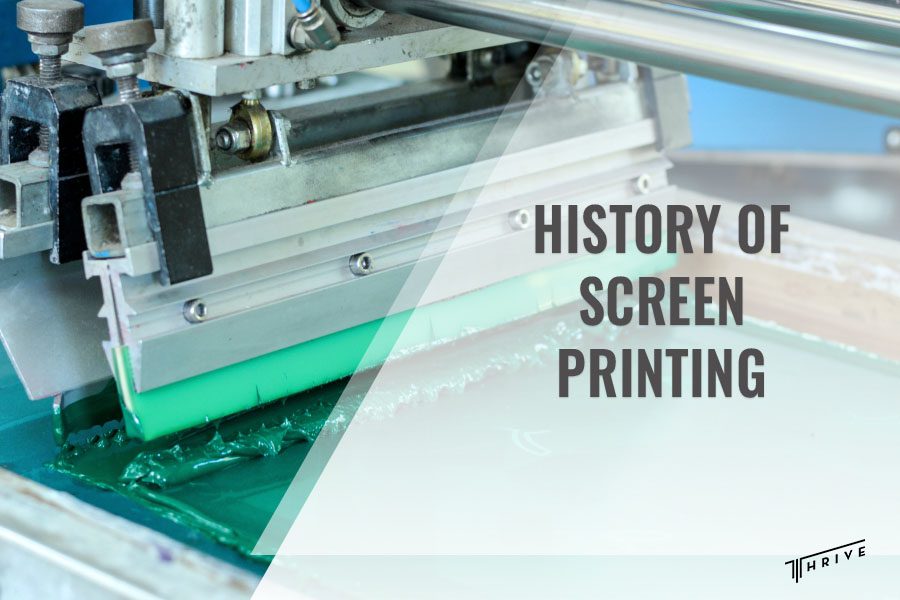Screen printing is currently one of the most popular methods for printing various commercial and retail products, including T-shirts and other pieces of clothing. But, to get there, the technique has changed throughout the years, making the history of screen printing captivating.
Our guide will teach you more about screen printing, starting with its origin and finishing with some interesting facts. Let’s find out when was screen printing invented and the hidden mysteries behind screen printing, one layer and mesh screen at a time.
History of Screen Printing
Screen printing is an ancient art that uses the stenciling method to transfer ink on different types of surfaces. Today, we use it for creating custom clothing, artwork, posters, and other products. But where and when did screen printing start?
The origins of screen printing go back to China. It is believed that screen printing was invented during the Song dynasty between 960 and 1279 AD. There is no exact date when was screen printing first used. But what we know is that people used stenciled designs on the walls of prehistoric caves in ancient times.
What is the oldest method of screen printing?
As a contract printing company in the industry, it is amusing to see what people did before the advanced technology hit. The first screen printing technique transferred intricate designs onto fabrics. For that purpose, people started using woven mesh and block stencils.
After China, Japan took it a step further and is considered the first country to innovate the printing method. Interestingly, the Japanese started cutting stencils out of paper and weaving mesh from human hair. They were forcing the ink through the mesh with specially designed stiff brushes.
As the technique developed, human hair as a material of choice for mesh was replaced by silk. After this revolutionary step taken by the Japanese, the screen printing method started to be known as silkscreen printing.
Screen printing arriving in Europe
It took a while for screen printing to find its way to Europe. The main reason for that was the shortage and the cost of silk.
France was one of the first European countries to use silk screens for printing onto fabrics in the 17th century. However, they were using stiff brushes to press the ink through the mesh.
But, when silk became widely available in the 18th century, screen printing as a technique started gaining Western Europeans’ interest. Merchants who were trading along the Silk Road were responsible for bringing the printing method to the European continent.
During the last years of the 18th century, people in America and the UK started using wax paper handwriting stencils fixed into a frame. A rubber squeegee was used to force the ink through the stencils. The Americans called the stencil frame “mimeograph”, while the British named it “cyclostyle”.
The invention of the screen printing technique we use today
One of the best-known names in the history of screen printing is Samuel Simon from Manchester, England. He was the first to receive a patent for the silk screen printing process in 1907.
In his patented method, which is similar to the one we utilize today, he used rubber blades to push the ink through the screen. Simon’s technique was commonly used for printing wall coverings on fine fabrics, such as silk, linen, and paper.
During the same time, a group of three men, Beck, Peter, and Owens, also revolutionized the commercial screen printing industry. They started using photo-image stencils for screen printing for the first time.
Compared to the chemicals like sodium, ammonium chromate, dichromate, and actinic light the famous trio used, today we use less-toxic and much safer sensitizers without bichromates for screen printing.
Screen printing in America
Screen printing started to be widely used during the First World War. As Samuel Simon patented the screen printing process in England, John Pilsworth did the same in America in 1914. He started using the patented multi-color printing technique for textile prints for industrial purposes, such as printing flags and banners.
Another important person in America’s screen printing history is Anthony Velonis. He started using the silk screen methods in the New York WPA and published a booklet about the technical problems of the process in 1937.
One year later, The National Serigraph Society was formed. Among other things, the group of artists came up with the word “serigraphy” and used it for their artistic application of screen printing on paper. With the term, they wanted to exclude themselves from the industrial use of the printing method.
Screen printing since 1960
As the printing technique developed, artists and printers started using it on other surfaces in addition to textile prints. Screen printing was used for putting designs on DVDs, glass, metal, wood, and paper. It also took a huge hit in mass-produced media for printing protest signs and posters.
Most famous screen print of all time
Andy Warhol is one of the people responsible for the popularization of screen printing. He is the person behind the most popular screen print of all time – Marilyn Diptych. The silk printing is a bold-colored portrait of Marilyn Monroe.
First rotatable multicolor garment screen printing machine
Thanks to the bright mind of Michael Vasilantone, screen printing was made a lot easier with his invention of the rotatable multicolor machine. At first, his intention was to use the machine for printing logos and information on bowling garments. However, Vasilantone’s machine was later used for printing T-shirts.
The Modern Era of Screen Printing
Today, screen printing is one of the most commonly used techniques for printing T-shirts and other garments. However, its use is not only limited to clothes. In fact, today, different types of printing presses can be used for clocks, watches, balloons, product labels, medical devices, posters, and other paper products.
By using screen printing technology, we offer our clients many benefits, such as versatility of use, durable and vibrant designs, cost-effectiveness, and a fast printing process.
In the modern era of screen printing, we use a screen printing press to make multiple copies of one design on garments. In the screen printing industry, we use three types of screen printing press such as manual, semi-automatic, and fully automatic.
Generally, most of the screen printing process today is mostly automated. The drawing of the squeegees is either done by air compressors or electric motors.
The Future of Screen Printing
The future of screen printing is likely to involve advancements in the digital technologies being used and focusing on developing eco-friendly techniques. Some of the innovations we predict will run the screen printing industry in the years to come are improved efficiency and more intricate designs.
Furthermore, full automation of the process is set to play a pivotal role in the industry. Some of the many benefits we can expect are reduced margins of error and textile prints with higher quality and durability.
We also hope that within the next years, automation and the new machines will reduce the common challenges we face every day, such as:
- Loss of details
- Problems with ink viscosity
- Contaminations and leaks
- Bubbles on the printed designs
- Ink spreading
Conclusion
Knowing how old is screen printing and its evolution gives us a better understanding of why it is one of the most used printing techniques. From humble beginnings and limited use, the printing technique has grown to be used by almost every industry.
As we look back at the history of screen printing, we have a clear picture of how has the technique adapted according to the circumstances. History teaches us about the possibilities of screen printing and gives us the motivation to continue working and improve the method.

Robert Fisher is the founder and CEO of Thrive Screen Printing and brings extensive experience in the screen printing and fulfillment industry.


